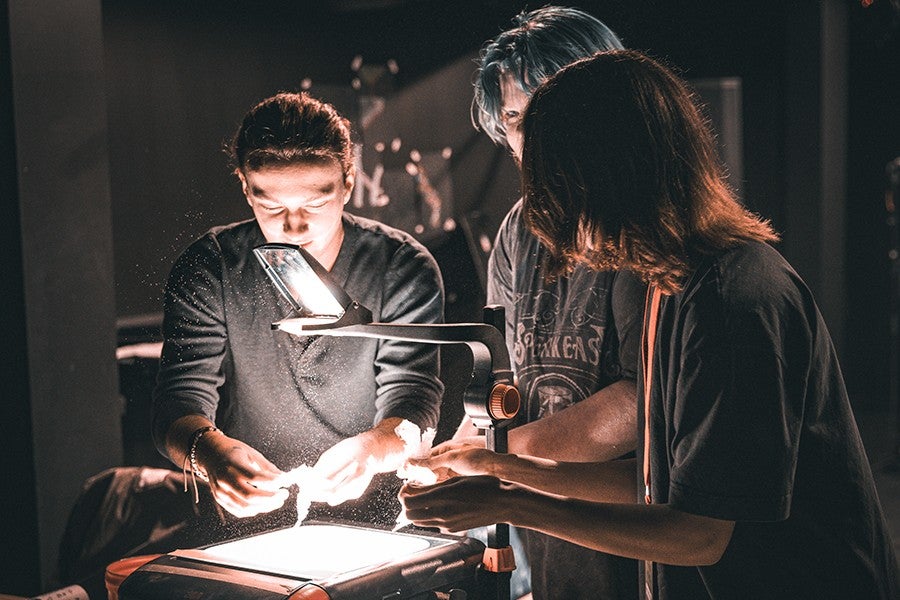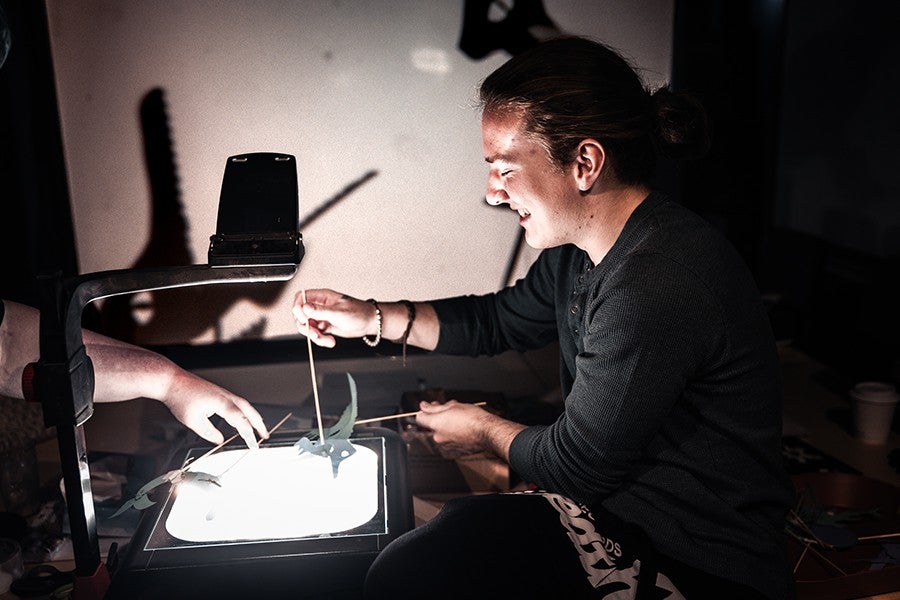Seeing puppets in a new light: Interdisciplinary Arts students explore shadow puppetry in weeklong workshop
Under the guidance of puppeteer and stage manager Alexandra Herryman, students learned how to use the Makerspace’s 3D printers and Cricut machines to create their own shadow puppets.
This fall, Interdisciplinary Arts students explored puppetry through a weeklong workshop led by Alexandra Herryman.
A puppeteer, stage manager, and Interlochen Public Radio Office Manager, Herryman learned to design and build puppets at Puppet Showplace Theater in Brookline, Massachusetts. Herryman presented devised works as part of the Puppet Showplace Theater’s artist incubator program, and has built puppets and coached puppeteers for several of Interlochen Arts Academy’s student theatre productions.
Under Herryman’s guidance, students learned how to use the tools in Interlochen’s Makerspace—such as 3D printers and Cricut machines—to create their own shadow puppets.
“We are digging into the nuts and bolts of construction: how to design the positive and negative space, how to joint the moving pieces, and options for stage and presentation,” Herryman says. “I want each student to walk away understanding the step-by-step process for creating a puppet that does what it needs to do according to the text or intention of the story.”
The workshop, which took place Oct. 21-25 as part of Steven Speciale’s Art & Technology classes, was inspired by conversations between Herryman and Director of Interdisciplinary Arts Clyde Sheets during the spring 2024 world premiere production of Edmonia. Although Sheets and Herryman have worked together in the past—both were previously members of the Interlochen Presents team, and Sheets’ students have served as backstage crew for productions Herryman managed—Edmonia provided an opportunity to collaborate more closely, discover their shared interest in puppetry, and brainstorm ideas for a workshop for Interdisciplinary Arts students.
“The Interdisciplinary Arts Division is all about original work and storytelling, and puppetry is a great ‘wrapper’ for all of that,” Sheets says. “You can do things with puppetry that you couldn’t do with live actors. You can do anything with a puppet.”
Speciale echoes Sheets’ thoughts about the myriad possibilities of puppetry and the artform’s alignment with the Interdisciplinary Arts curriculum.
“You can really make a puppet out of anything,” he says. “While there’s no end to the level of sophistication that’s possible, there’s also a low barrier to entry, so it’s appropriate for people who have never done it. There’s an interdisciplinary aspect to puppet making, because it involves aspects of theatre, but there’s also so much craft.”
Herryman decided to focus the workshop on shadow puppetry because of the resources available in Interlochen’s Makerspace.
“Having access to 3D printers and Cricut machines naturally suggested shadow puppets,” Herryman says. “For generations, shadow puppets have been hand-cut, painstakingly, one by one, with a blade and a piece of cardstock. One mistake—or the cat spilling coffee on your project—has always meant starting over. Now, with the Cricut, you can replicate a design in minutes, or change the facial expression or the perspective. The 3D printer can create all sorts of joints and control rods that used to take hours to make with bamboo skewers and duct tape. The potential for innovation in this art form with this technology is huge.”
Herryman says that while Jim Henson-style puppetry has long been the most popular style in the United States, shadow puppetry is beginning to gain traction through the work of theatre companies such as Manual Cinema and artists like Katherine Fahey. She also believes it’s an ideal style for students.
“Shadow puppetry is a style that allows for a lot of creativity, is inexpensive to produce, does not require spoken words, and translates to film very easily, which I think are great qualities in an art form for young artists,” Herryman says.
Ultimately, the puppetry workshop was an opportunity for Interdisciplinary Arts students to add a new artform to their creative toolkit.
“I hope shadow puppets become one more item in students’ artistic problem-solving repertoire,” Herryman says.








